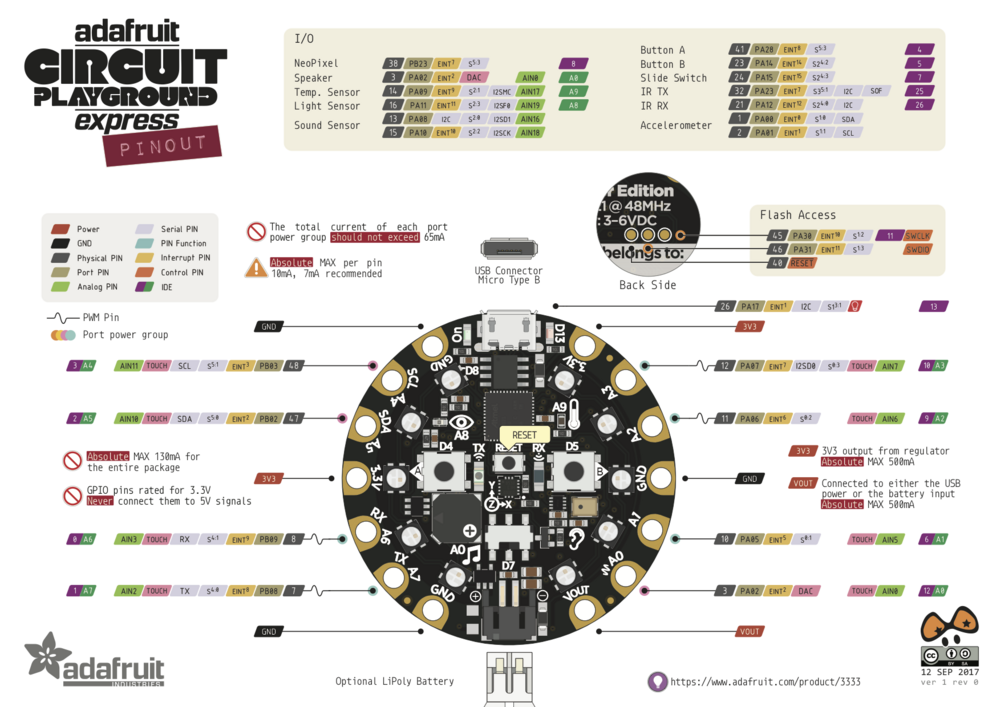« Broder avec du fil conducteur » : différence entre les versions
| Ligne 19 : | Ligne 19 : | ||
== Développement avec le Circuit Playground Express == | == Développement avec le Circuit Playground Express == | ||
Le [[Adafruit Circuit Playground Express]] (CPX) permet d'implémenter divers types de dispositifs. On peut le programme en [[MakeCode]], [[Arduino]] ou [[Circuit Python]] | Le [[Adafruit Circuit Playground Express]] (CPX) permet d'implémenter divers types de dispositifs. On peut le programme en [[MakeCode]], [[Arduino]] ou [[Circuit Python]]. Ce microcontrôleur possède un grand nombre d'entrées et des sorties, ainsi que des sensors. Voici le diagramme officiel: | ||
[[Fichier:Adafruit Circuit Playground Express Pinout.png|1000px|vignette|néant|Adafruit_Circuit_Playground_Express_Pinout]] | |||
=== Astuces === | === Astuces === | ||
Version du 2 février 2023 à 16:07
Introduction
Cet article est une ébauche à compléter. Une ébauche est une entrée ayant un contenu (très) maigre et qui a donc besoin d'un auteur.
Points de broderie et résistance
La resistance est fonction de la densité de fil et de la distance.
- Plus il y en a, moins il y a des la resistance, par exemple par example 3 lignes adjacents de triples points ou encore un point droit couvert par un satin devrait offrir moins de resistance qu'un point droit simple
- Ensuite la resistance augmente avec la distance.
Caractéristiques de fils conducteurs et réglages
On fera nos premiers essais avec du fil de Madeira
Madeira HC 12
Caractéristiques selon le constructeur: Heavy fully silver-plated dtex 235x2 embroidery thread with resistance < 100 Ohm/m. Suitable for robust circuitry and all applications where a very low resistance is required. Available on 1000 m cones for 100/16 needles. (High conductive embroidery threads) (consulté 1/2023).
Madeira HC40
Caractéristiques selon le constructeur: The all-rounder among conductive threads. Easy to use dtex 117x2 embroidery thread for standard 75/11 or 80/12 needles. The resistance of <300 Ohm/m can be varied by using conductive bobbin thread or varying the stitches. Available on 2500-metre cones. (High conductive embroidery threads) (consulté 1/2023).
Développement avec le Circuit Playground Express
Le Adafruit Circuit Playground Express (CPX) permet d'implémenter divers types de dispositifs. On peut le programme en MakeCode, Arduino ou Circuit Python. Ce microcontrôleur possède un grand nombre d'entrées et des sorties, ainsi que des sensors. Voici le diagramme officiel:
Astuces
- Pour créer un "bouton", il suffit de broder un point triple.
- Il faut vérifier la broderie, notamment couper les fils de saut (regarder des deux côtés)
- Après avoir connecté une nouvelle entrée ou sortie, il faut redémarrer le CPX, c-a-d cliquer sur le petit bouton reset au centre.
Liens
Exemples
- Exploring e-textiles by Lara Tomholt. Décrit un projet avec broderies décoratives et un fil qui au toucher allume diverses LED, selon la position du doigt.
- Conductive thread embroidery by Jacky Puzey, 2018. Montre un exemple fait avec le fil Madeira HC 40. Pas d'explications.
- Making E-Textile Interfaces with Trill Craft by Becky Stewart (2020), Bela. Project with hand sewn conductive thread and conductive fabric (que l'on pourrait remplacer avec un tatami brodé). Il y a d'autres projets intéressant sur ce site.
Introductions
- Tomas Blecha, Radek Soukup, Jan Reboun & Miroslav Tichy (2020). Conductive Hybrid Threads and Their Applications (overview of some serious applications)
- Conductive Thread - 10 Tips, Adafruit Industries (sewing)
- Tufting With Conductive Thread, E-Textile Sensor Experiments: combining traditional textile techniques with computer interaction, by Yuchen Zhang, dec 2018. (for hand embroidery)
- LilyPad Basics: E-Sewing, by Gella, (not dated, sewing tips, in particular for Lilypad users)
- Embroidering Conductive Thread with a Janome MC 200E embroidery machine (short technical embroidery discussion related Embird, not very useful for other purposes).
- Insulation Techniques for e-Textiles, by Gella, (five different methods for insulating conductive thread traces in an e-textile project)
- Machine Embroidery Covering Conductive Thread, by Lynne Bruning (show how to cover conductive thread with non-conductive satin stitches)
- Touch Me! Open Universal Input Sleeve {OUIS} , by CMoz, (shows how to use conductive sheets, embroidery is just for decoration)
- Speaking T-shirt ,by Techlab St Joost (shows how to use conductive paint)
- Printed electronic embroidery using conductive thread, by Natalie Fifeld, YouTube Video 2019.
- E-textiles par Trinidad G. Machuca . Un project fabracademy.
- Embroidering electrical interconnects with conductive yarn for the integration of flexible electronic modules into fabric, IEEE Explore, 2005.
Material
- High conductive embroidery threads. Website from Madeira that includes links to their two variants of conductive threads for machine embroidery, plus some extra information.
- Conductive Thread, by Becky Stern, Adafruit. It presents the 3ply thread for sewing, sold by this company. Also included a tutorial on how to sew it and use it with a CPX. On peut acheter ce fil soit chez Adafruit, soit chez un distributeur d’électronique, soit sur Amazon. Pareil pour le fil de Sparkfun (LilyPad)
Links
- Conductive Embroidery, PinInterest links by MarianaTamashiro
Articles divers
- Hamdan, N. A. H., Voelker, S., & Borchers, J. (2018). Sketch&Stitch: Interactive embroidery for E-Textiles. In Conference on Human Factors in Computing Systems - Proceedings (Vol. 2018-April, pp. 1–13). New York, New York, USA: Association for Computing Machinery. https://doi.org/10.1145/3173574.3173656
- Mattila, H.R. Intelligent Textiles and Clothing. North America: Woodhead Publishing Limited, 2006. E-Textiles For Wearability: Review Of Integration Technologies. Textile World [online]. [cit. 2017-01-13]. Available from: http://www.textileworld.com/textile-world/features/2010/04/e-textiles-for-wearability-review-of-integration-technologies/ SOFT SENSING STRUCTURES. Smart Textiles Design Lab Blog [online]. The Swedish School of Textiles, 2016 [cit. 2017-06-07]. Available from: http://stdl.se/?p=3864 R. Polanský, et al., A novel large-area embroidered temperature sensor based on an innovative hybrid resistive thread, In Sensors and Actuators A: Physical, Volume 265, 2017, Pages 111-119, ISSN 0924-4247
- Stavrakis, A.K.; Simi ́c, M.; Stojanovi ́c, G.M. A Study of the Performance Degradation of Conductive Threads Based on the Effects of Tensile Forces and Repeated Washing. Polymers 2022, 14, 4581. https://doi.org/10.3390/polym14214581
- Wright, R., & Keith, L. (2014). Wearable Technology: If the Tech Fits, Wear It. Journal of Electronic Resources in Medical Libraries, 11(4), 204–216. https://doi.org/10.1080/15424065.2014.969051
